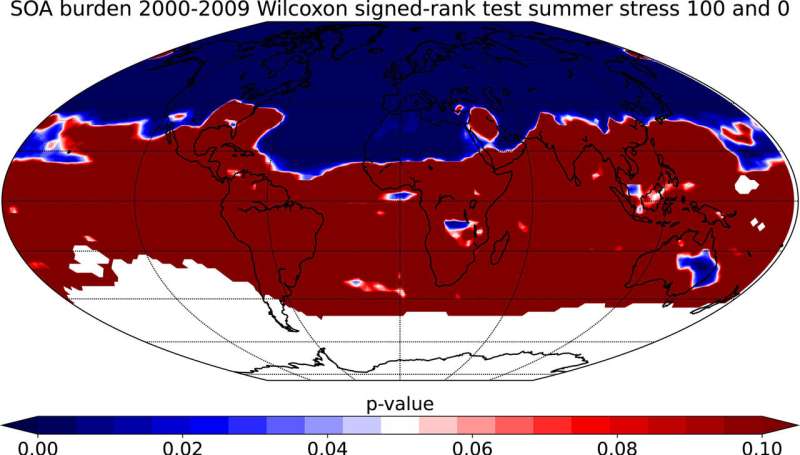Wilcoxon signed-rank test of secondary organic aerosol (SOA) burden from summer from 10-year period between the upper bound and base simulations. Credit: Journal of Geophysical Research: Atmospheres (2022). DOI: 10.1029/2022JD036733
Plants can release certain chemicals to shield themselves from high temperatures and potentially communicate with other plants. They also release these chemicals in response to stress, including when insects chomp on their leaves. Now, in a study published in the Journal of Geophysical Research: Atmospheres, scientists have found that insect-damaged plants could release enough of these molecules, called volatile organic compounds, to locally alter the atmosphere and radiative budget above a forest.
Once panicking plants release the compounds into the air, the compounds can oxidize, transforming into organic aerosols. Like aerosols emitted from human activity, these aerosols can theoretically change how clouds form and how much sunlight clouds reflect. Now for the first time in a global atmospheric model, Holopainen et al. consider the potential influence insect-munched plants can have on aerosol concentrations and clouds.
The researchers simulated an insect infestation in evergreen and deciduous trees on a global scale. They modeled changes in aerosols, cloud formation, and cloud reflectivity that resulted from infestations that affected up to 100% of needleleaf evergreen trees and broadleaf deciduous trees. The researchers found that the largest infestations led to a 50% increase in the number of cloud droplets above the forests. Clouds over densely forested areas had the greatest changes in cloud droplet concentration and radiation.
These results suggest that insects eating plants could lead to stronger cooling effects from clouds, as greater aerosol concentrations typically correlate with sending more solar radiation back into space. These localized impacts won't happen in an instant, but still, climate models could incorporate aerosol emissions from areas with intense insect herbivory to best estimate potential impacts on local atmospheric processes, the authors say.
More information: E. Holopainen et al, Insect Herbivory Caused Plant Stress Emissions Increases the Negative Radiative Forcing of Aerosols, Journal of Geophysical Research: Atmospheres (2022). DOI: 10.1029/2022JD036733
Journal information: Journal of Geophysical Research - Atmospheres
Provided by Eos
This story is republished courtesy of Eos, hosted by the American Geophysical Union. Read the original story here.
























